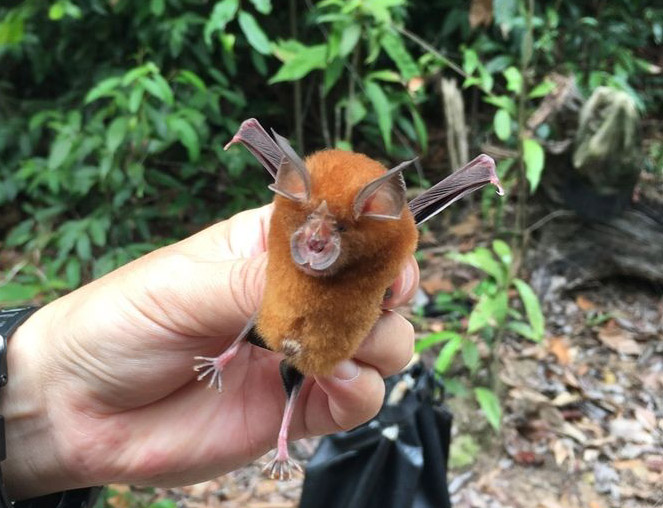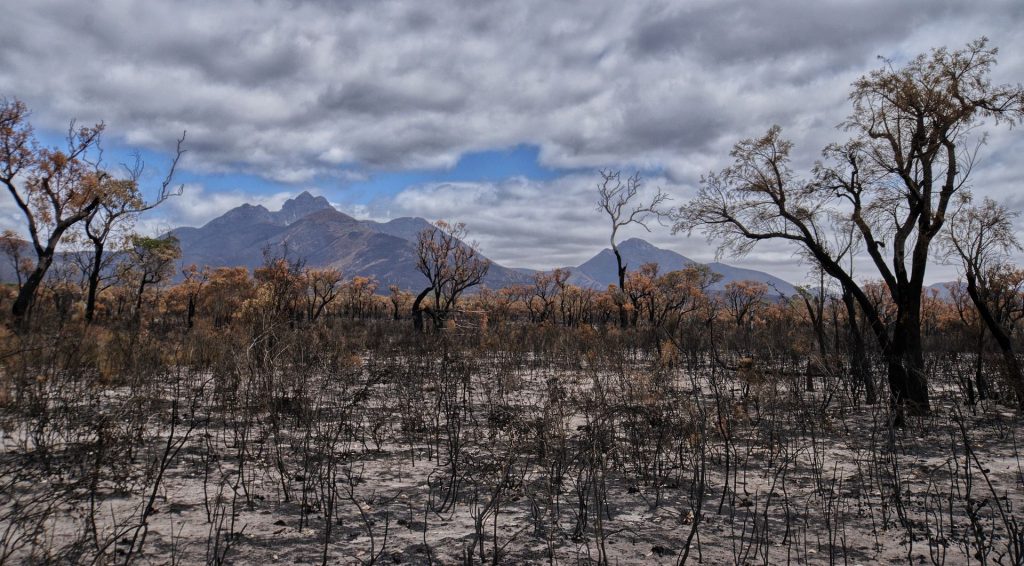The underlying cause of the COVID-19 pandemic is the spill-over of a virus from a presumed bat wildlife source – and its spread in the vast human population and its vulnerable systems. There are many questions yet unanswered about the virus’s source – which species of bat, was it sold in the Wuhan Wet Market, did a number of bat-human transmissions occur or were transmissions to other animal species involved in the development of a virus capable of human to human transmission. For the moment all efforts are on controlling the disease. It has emerged and spread rapidly around the highly connected planet. In the long run, understanding how to prevent further such pandemics will be a major focus.

Link to license: https://creativecommons.org/licenses/by-nc/4.0/legalcode
What we know at this point in time is that viruses from animals, mostly from wildlife have dominated novel infectious diseases of the last few decades, and are the cause of several pandemics – HIV AIDs, SARS corona virus, Ebola virus, Nipah virus and the familiar but regularly changing influenza virus. We are increasingly coming into greater direct and indirect contact with wildlife through accelerated land-use change, especially deforestation; climate change; the adaptation of some species to our human landscapes and the consumption and trade of wildlife. This exposes us to wildlife viruses but is a double tragedy. These processes are also accelerating biodiversity loss and the degradation of natural environments.
Targeted surveillance of novel virus spill-over hotspots and wildlife hosts are required. However, it is essential not to overlook the broader risks of environmental degradation of which emerging diseases are only one part. Degradation of natural environments results in loss of ecosystem services – clean water, clean air, climate regulation, recycling of nutrients and waste, fertile soils to grow food, pollination, livelihoods, recreational and cultural opportunities. Natural environments are also the source of traditional medicines and have other direct impacts on physical, mental and social health. The emergence of COVID-19 should serve as a warning that we degrade natural environments at our own peril.
It is also important to understand the interconnections. As again COVID-19 reminds us – health, education, poverty, vulnerable groups, food security, economic stability and justice as well as biodiversity loss and climate change are tightly interwoven. Navigating to the other side of this crisis needs to be informed by this knowledge.
Our climate and environment need to be in the best and most stable state for us to pursue good health. Tragically, the Pacific island nation of Vanuatu is faced with responding to devastation caused by a category 5 cyclone on top of its response to COVID-19. The Bay of Bengal is now also dealing with two emergencies following Cyclone Amphan. Ignoring vulnerable groups and inequality is not only socially unjust but is a source of weakness in strategies to safeguard population health. As an example, Singapore’s early success in containing the virus has been undermined in the overcrowded dormitories of its migrant workers.
Decoupling economies from environmental destruction and from promoting inequity is in our long- (and near-) term interest. Addressing these agendas and the interconnections described above are at the heart of the UN Sustainable Development Goals (SDGs, https://sustainabledevelopment.un.org/?menu=1300) and a vision of a sustainable, desirable and equitable future. As the global population looks out at a world unravelling from a pandemic kindled by the unrelenting pressure on our environment, and sustained through inequity, such a vision beckons to galvanise action.
However, for 2020-2030 to be the SDG’s Decade of Action there is still work to be done. Addressing 17 cross-sectoral goals and 169 targets concurrently is a mammoth task. In 2018-19 over 100 experts reviewed the forestry sector, forests and forest-dependent populations goal by goal, and then across goals, to identify synergies and trade-offs to inform policy development. The results are published in “Sustainable Development Goals, their Impacts on Forests and People” (Katila, Coffer, de Jong, Galloway, Pacheco and Winkel, 2020). Forests cover about a third of all land surface and represent some of the most productive natural ecosystems so addressing the goals in this context is a substantial contribution to the global effort. I led the chapter on Goal 3: ‘Good Health and Wellbeing for all’ which dealt in detail with the impact of Goal 3 targets on people and forests.

At the time we launched the book at the IUFRO World Congress in Curitiba, Brazil in October last year the Amazon was on fire. The world responded in alarm to this globally significant threat to climate stability. There were many further consequences for Brazil. The impact of uncontrolled fires and transnational haze on respiratory health was already a feature of our chapter on SDG 3 Health and Wellbeing. The events in Brazil highlighted the increased vulnerability of forest-dependant populations.
Concurrent to the fires, the government withdrawal of doctors from remote forest health centres that support largely indigenous forest-dependant populations, threatens the survival of these groups. The high fertility rate, child and maternal deaths in remote regions compared to the below replacement fertility in cities is a reminder of the shortfall in universal access to family planning, and its consequences. In Brazil, 99% of malaria cases occur in the Amazon Basin along the deforestation frontier. There, water holding rutted ground and deforestation patches favour vector mosquitoes which infect susceptible immigrant farmers, and their children. The tragedy of thousands of Brazilian five-year old’s with Zika virus-associated microencephaly is a reminder of the impact of another forest-derived zoonotic disease but also that the cost is borne most heavily by remote communities in the north east of the country.
Two months later, my home country of Australia was on fire. Over summer, 20% of our forests burnt in wildfires. Prolonged drought had already devastated rural communities, many of which had run out of water and forests were tinder-dry. In addition to 33 direct deaths, another 417 premature deaths, more than 3,000 hospitalisations with cardiorespiratory problems and 1,000 asthma-related hospitalisations have been attributed to the fires. Over a billion animals are believed to have died, including those of critically endangered species.
Over half of all Australians were exposed to hazardous air pollution. Many had only just ceased wearing face masks outside and sheltering inside from the relentless smoke that had also discoloured glaciers in New Zealand and reached as far as South America – when COVID-19 struck. Like other nations our attention is currently on managing the crisis and supporting those who are sick – battling another, more acute, respiratory disease. Like other nations, we are also heading towards an uncertain economic future.
As I have illustrated briefly above, both developed and developing countries are facing not only COVID-19 but many other challenges to health and wellbeing stemming from an unsustainable exploitation of the environment, and of other human beings. These crises appear to be coming more frequently and even overlapping. Clearly, we need to confront these challenges urgently. To succeed in addressing many intersecting issues we need to work together. Globally, [almost] all nations are signatories to the UN Sustainable Development Goals. This provides an existing, agreed framework for an alternative future that address underlying flaws in our current systems, and puts inequity and the environment, including our forests and forest-dependant populations, at the centre of our concerns.
Taking this moment to review future options through this framework while we are all already operating outside Business As Usual maybe the opportunity of a lifetime.
——
Dr Ro McFarlane is Assistant Professor of Ecological Public Health at the University of Canberra, Australia.
ro.mcfarlane@canberra.edu.au
In the blog she refers to:
McFarlane, R.A, Barry, J., Cisse, G., Gislason, M. Gruca, M., Higgs, K., Horwitz, P., Nguyen, G.H., Sahu, S. Butler, C.D. (2020) Good Health and Well-Being – Framing Targets to Maximise Co-Benefits for Forests and People. In Katila, P., Colfer, C., de Jong, W., Galloway, G., Pacheco, P. and Winkel, G. (eds.) Sustainable Development Goals: Their Impacts on Forests and People. Cambridge University Press, pp. 72-107. https://www.cambridge.org/core/books/sustainable-development-goals-their-impacts-on-forests-and-people/5FA75743F80CCE33751BD2095E5754DC. The development of this publication was supported by the Ministry for Foreign Affairs of Finland and Natural Recourses Institute Finland.
Disclaimer This guest blog was prepared or accomplished by Dr Ro McFarlane in her personal capacity. The opinions expressed in this guest blog are the author’s own and do not reflect the opinions or views of IUFRO or its members.

Leave a Reply